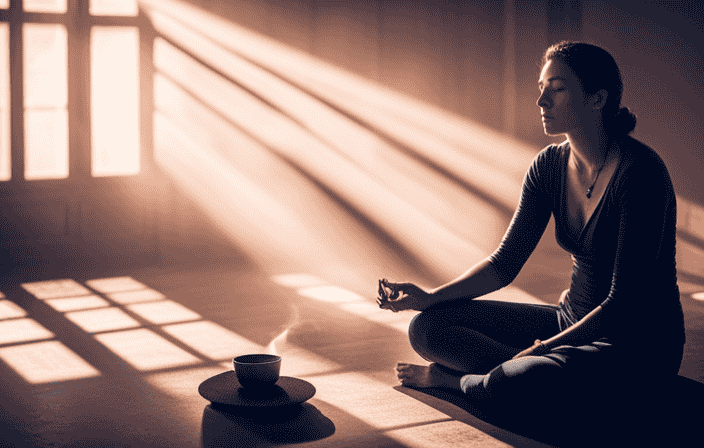You might be thinking, ‘Why do I need guided meditation when I can just meditate on my own?’ Well, let me tell you, guided meditation is not just any ordinary meditation practice. It offers a wealth of benefits that can transform your well-being and inner peace.
From reducing stress and improving focus to increasing self-awareness, guided meditation provides a structured and relaxing experience that enhances your overall meditation practice.
In this article, we will explore the power and benefits of guided meditation, and why it’s worth incorporating into your daily routine.
Key Takeaways
- Reduces stress
- Improves focus
- Increases self-awareness
- Enhances overall well-being
What is it?
Guided meditation is a practice that provides structure, support, and relaxation techniques, allowing me to cultivate mindfulness and self-discovery amidst the chaos of modern life. It is a powerful tool that offers a pathway to inner peace and transformative benefits.
Through verbal cues and visualizations, guided meditation helps me to focus my attention and become more self-aware. It reduces stress, enhances my overall well-being, and cultivates a sense of inner calm.
Whether I am a beginner or an experienced meditator, guided meditation offers the guidance I need to deepen my practice and explore my inner world. It provides a framework for personal growth and serves as a valuable tool for relaxation and focus.
With its flexibility and accessibility, guided meditation has become an essential part of my daily routine, allowing me to experience mental resets and immersive experiences whenever I need them.
Effectiveness and Benefits
I find that practicing meditation with guidance enhances my focus and self-awareness. Guided meditation provides a framework for personal growth and cultivates mindfulness. It is highly effective for relaxation and helps me achieve a state of inner peace.
The verbal cues and visualizations used in guided meditation help me stay present and engaged in the practice. This form of meditation also serves as a valuable tool for enhancing my overall meditation practice. It provides mental resets and immersive experiences that allow me to dive deeper into my inner world.
By practicing guided meditation, I am able to reduce stress, improve my ability to concentrate, and increase my self-awareness. It is a powerful practice that offers structure and relaxation techniques, making it accessible and beneficial for individuals at all levels of experience.
Differences from Regular Meditation
Regular meditation involves independent practice, while guided meditation provides support and guidance through verbal cues and visualizations. In regular meditation, individuals are responsible for their own practice, relying solely on their own techniques and experiences. On the other hand, guided meditation offers a structured framework and assistance for those who may be new to meditation or seeking additional support. The use of verbal cues and visualizations in guided meditation helps to cultivate a deeper sense of relaxation and focus.
To illustrate the differences between regular meditation and guided meditation, consider the following table:
| Regular Meditation | Guided Meditation |
|---|---|
| Independent practice | Provides support and guidance |
| Relies on personal techniques | Uses verbal cues and visualizations |
| Suitable for experienced meditators | Helpful for beginners or those seeking support |
| No structure provided | Offers a structured framework |
| Less focus on relaxation techniques | Enhances relaxation and focus |
By understanding these distinctions, individuals can choose the approach that best suits their needs and goals in their meditation practice. Guided meditation provides a valuable tool for enhancing meditation practice, offering a supportive and immersive experience that can lead to a deeper sense of self-awareness and overall well-being.
Duration and Flexibility
Duration and flexibility of guided meditation sessions can vary depending on personal preferences, time availability, and goals. One of the great things about guided meditation is that it can be adapted to fit individual needs.
Whether you only have a minute to spare or you want a more immersive experience, there are options available. Quick mental resets can be achieved with shorter sessions, while longer sessions provide a deeper and more immersive experience.
The flexibility of guided meditation allows you to practice whenever and wherever you want. It can easily be incorporated into your daily routine, whether it’s during a break at work or before bed.
With guided meditation, you have the freedom to choose the duration that works best for you and your schedule, making it a highly accessible practice.
Cost and Accessibility
The cost and accessibility of guided meditation classes can vary depending on location and platform. Here are three key points to consider:
-
Pricing Options: Meditation studios may charge anywhere from $10 to $30 per class, while online platforms and apps often offer subscription models ranging from $5 to $20 per month. This wide range of options allows individuals to find a pricing plan that suits their budget.
-
Free Resources: Fortunately, there are also free guided meditation resources available online. These can be a great starting point for beginners or those who want to explore guided meditation without any financial commitment.
-
Wide Range of Options: Whether you prefer in-person classes, online platforms, or mobile apps, there is a wide range of options available to suit different preferences and budgets. From well-established meditation centers to emerging digital platforms, there is something for everyone.
Considering the various pricing options and the availability of free resources, guided meditation is accessible to individuals with different budgets and preferences.
Guided Meditation for Children
I find it fascinating how guided meditation can be beneficial for children, offering them techniques and resources to cultivate mindfulness and relaxation. Children can greatly benefit from guided meditation as it provides them with a structured and engaging way to develop self-awareness and emotional well-being. It helps them navigate the chaos of modern life and teaches them valuable skills that they can carry with them into adulthood.
Here is a visualization of how guided meditation can benefit children:
| Benefits of Guided Meditation for Children |
|---|
| Cultivates mindfulness |
| Enhances focus and attention |
| Reduces stress and anxiety |
Guided meditation for children often incorporates playful visuals, interactive elements, and mindful activities to make it engaging and enjoyable. By introducing meditation at an early age, children can develop a lifelong practice that promotes inner peace and emotional resilience.
Guided Meditation at Work
Now that we have explored the benefits of guided meditation for children, let’s shift our focus to the workplace.
Guided meditation can be a valuable practice to incorporate into our daily work routines, allowing us to find moments of calm and focus amidst the busyness of our professional lives.
By practicing guided meditation at work, we can create a more peaceful and stress-free environment. Whether we have a dedicated meditation space or not, we can easily integrate mindfulness into our everyday tasks. Taking mindful breaks and practicing deep breathing techniques can help us reduce stress, increase our focus, and enhance our overall well-being.
Here are three ways guided meditation can be beneficial at work:
-
Improved Focus: Guided meditation provides a framework for cultivating mindfulness, allowing us to stay present and fully engaged in our work tasks.
-
Reduced Stress: Taking mindful breaks and practicing deep breathing exercises can help us relax and release tension, resulting in reduced stress levels.
-
Enhanced Productivity: By incorporating guided meditation into our work routine, we can increase our productivity by improving our ability to concentrate and make clearer decisions.
By integrating guided meditation into our work lives, we can create a more harmonious and fulfilling work environment for ourselves and our colleagues.
Mindfulness and Self-Discovery
Practicing mindfulness and self-discovery through guided meditation allows me to explore my inner thoughts and emotions in a structured and supportive way. As a beginner, I appreciate the guidance and relaxation techniques provided during these sessions. It helps me cultivate awareness amidst the chaos of modern life and connect with myself on a deeper level.
The structured nature of guided meditation allows me to focus on the present moment and let go of distractions. It provides a pathway to mindfulness and self-discovery, allowing me to cultivate inner peace and enhance my overall well-being. Through this practice, I have gained valuable insights about myself and have experienced transformative benefits.
Guided meditation has become an essential tool in my journey of self-exploration and personal growth.
Related Posts and Resources
Exploring related posts and resources expands my knowledge and understanding of various aspects of guided meditation and its transformative benefits. By delving into these additional materials, I gain a deeper insight into the practice and discover new techniques and perspectives that can enhance my mindfulness and self-discovery journey.
The related posts provide me with valuable information on topics such as guided sleep meditation, the step-by-step process of guided meditation for sleep, and a comprehensive guide on meditation itself. These resources offer a wealth of knowledge and practical advice, allowing me to further refine my practice and explore different avenues for personal growth.
By incorporating the techniques and insights from these resources, I can continue to cultivate awareness amidst the chaos of modern life and connect with my inner self, experiencing the powerful and transformative benefits of guided meditation.
Relaxation Techniques and Support
Utilizing various relaxation techniques and seeking support during my meditation practice has been instrumental in fostering a sense of calm and inner peace. The power of guided meditation lies in its ability to provide structure and support, allowing me to fully immerse myself in the practice.
Here are three key relaxation techniques and forms of support that have enhanced my meditation experience:
-
Breathing techniques: Focusing on my breath helps me relax and center myself. Deep breathing exercises, such as diaphragmatic breathing or alternate nostril breathing, promote relaxation and reduce stress.
-
Visualization: Guided meditations often incorporate visualizations, where I imagine calming scenes or visualize positive outcomes. This helps me create a mental space of tranquility and enhances my overall relaxation.
-
Affirmations: Guided meditations often include positive affirmations, which are powerful statements that help reframe my mindset. These affirmations reinforce self-belief, self-compassion, and positive intentions, providing support during challenging times.
By incorporating these relaxation techniques and seeking support through guided meditations, I have discovered a profound sense of relaxation, inner peace, and overall well-being in my meditation practice.
Ancient Practice with Transformative Benefits
Incorporating ancient meditation practices into my daily routine has brought about transformative benefits in my life. Guided meditation, in particular, has been a powerful tool for self-discovery and personal growth. By following the verbal cues and visualizations, I have been able to cultivate mindfulness and enhance my overall well-being.
This ancient practice has provided me with a framework for connecting with myself and finding inner peace amidst the chaos of modern life. The relaxation techniques and support offered through guided meditation have helped me reduce stress and increase self-awareness. I have found that this practice not only enhances my meditation sessions but also provides valuable mental resets and immersive experiences.
Overall, guided meditation has proven to be an ancient practice with profound transformative benefits that have positively impacted my life.
Frequently Asked Questions
How can guided meditation be incorporated into daily life?
To incorporate guided meditation into daily life, I start by setting aside a few minutes each day for practice. I use a guided meditation app or follow a video online to help me relax, focus, and cultivate mindfulness. It’s a simple yet powerful way to reduce stress and enhance overall well-being.
Are there any specific techniques or apps designed for children to practice guided meditation?
Yes, there are specific techniques and apps designed for children to practice guided meditation. These tools incorporate playful visuals and interactive elements to make it engaging for kids, creating a calm space and introducing them to mindfulness at a young age.
Can guided meditation be practiced in a work environment without a dedicated meditation space?
Yes, guided meditation can be practiced in a work environment without a dedicated meditation space. One can incorporate mindfulness into everyday tasks, take mindful breaks, and practice deep breathing to increase focus and reduce stress.
What are some relaxation techniques and support offered in guided meditation?
In guided meditation, relaxation techniques such as deep breathing and progressive muscle relaxation are commonly used to support relaxation and stress reduction. These techniques help to calm the mind and body, promoting a sense of peace and well-being.
How can guided meditation connect individuals with themselves and inner peace?
Guided meditation connects individuals with themselves and inner peace by providing a structured framework for self-exploration and relaxation. Through verbal cues and visualizations, it cultivates self-awareness, mindfulness, and a sense of calm, leading to a deeper connection with oneself and inner peace.










